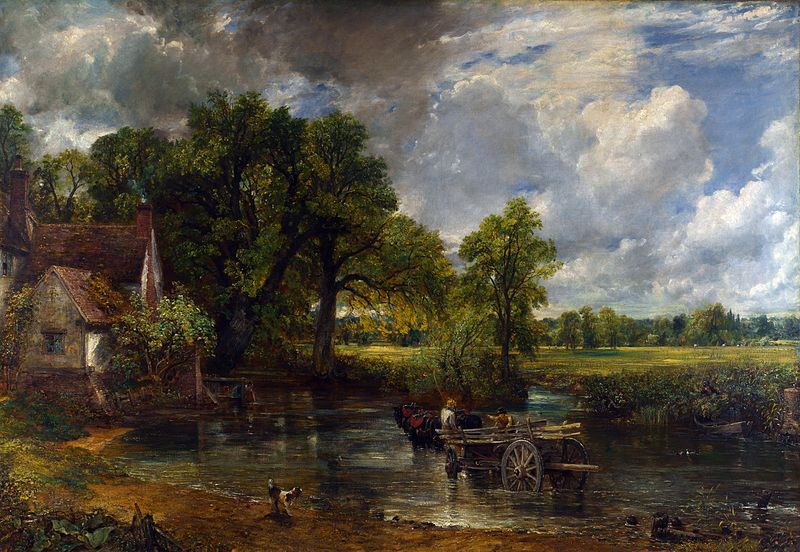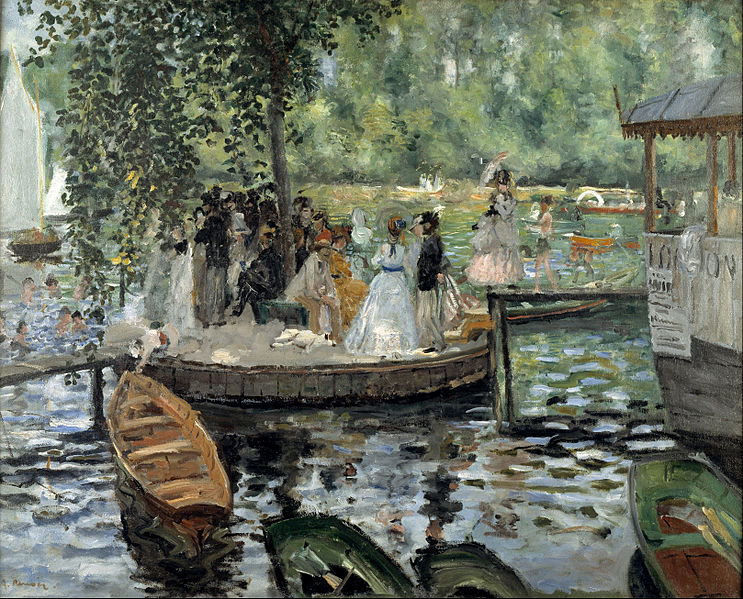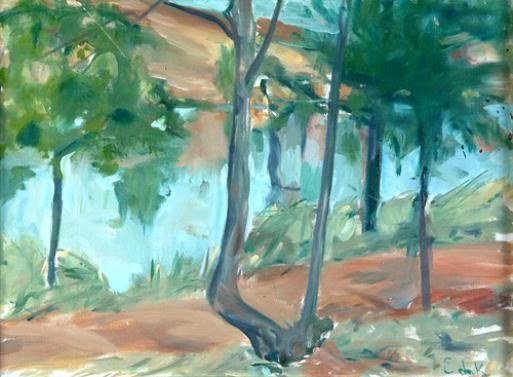Capturing Nature: 10 Tree Paintings That Made Art History
- The Symbolism and Inspiration Behind Tree Paintings
- Caspar David Friedrich "Cairn in Snow" (1807)
- John Constable "The Hay Wain" (1821)
- Gustave Courbet"Forest in Autumn" (1841)
- Pierre-Auguste Renoir "La Grenouillère" (1869)
- Claude Monet "The Artist’s Family in the Garden" (1875)
- Vincent van Gogh "Almond Blossoms" (1890)
- Meindert Hobbema "The Avenue at Middelharnis" (1689)
- Gustav Klimt "Avenue of Schloss Kammer Park" (1912)
- Egon Schiele "Four Trees" (1917)
- Elaine de Kooning "Untitled (Calcoon Woods)" (1964)
Throughout history, artists have been fascinated by the natural world, a passion that traces back from the earliest cave drawings to the intricate landscape canvases of later periods. This enduring attraction has given rise to an extensive collection of art centered around trees and forests. Many of the most acclaimed tree artists had already earned recognition in various art forms and movements before turning their attention to arboreal subjects. When it comes to illustrating trees and forests, their attempts frequently portray the dramatic changes in the seasons, providing artists with a wide range of color combinations to work with, from the earthy tones and golden hues of autumn's fallen leaf to the vivid flower splashes that greet spring.
A significant number of these artists preferred painting en plein air, immersing themselves in the natural environment. This approach not only enabled them to portray the true colors of the landscape but also provided them with the tranquility and invigoration of being outdoors. Their work in the realm of tree and forest paintings is celebrated for its contribution to landscape art, showcasing some of the most exquisite and renowned tree paintings ever created.
You will come across a diverse range of perspectives on tree art as you look through this collection; each artwork narrates the story of the creator's relationship with the natural world. This article may well lead you to discover a tree painting that resonates with you personally, adding a new favorite to your list of cherished art.
The Symbolism and Inspiration Behind Tree Paintings
In the world of tree art, trees have more symbolic implications than just being beautiful objects. They stand as powerful symbols of nature's resilience, embodying the enduring strength and vitality that allow them to weather the seasons and the years. Trees also represent a deep-rooted connection to the environment, reflecting a relationship that is both nurturing and majestic. The depiction of trees in art serves as a homage to their grandeur, inviting viewers to reflect on their own relationship with the natural world and the significance of preserving its beauty and diversity.
Artists who incorporate trees into their masterpieces often do so out of a profound love for nature. This affinity for the natural world is further encouraged by various art movements that promote plein air painting, or painting outdoors. This practice allows artists to engage directly with their environment, capturing the transient beauty of the landscape with authenticity and immediacy. The choice to feature trees prominently in their works is a testament to their desire to capture the essence of the natural world, celebrating its resilience, beauty, and the sense of tranquility it offers. Through their paintings, these artists invite us into a dialogue with nature, encouraging a deeper appreciation and understanding of the world around us.
Caspar David Friedrich "Cairn in Snow" (1807)

Caspar David Friedrich "Cairn In Snow" (1807)
Caspar David Friedrich's "Cairn in Snow," painted in 1807, embodies the sublime essence of Romanticism, capturing the profound solitude and beauty of nature. This artwork features a stark, serene landscape dominated by a snow-covered field, where a cairn, or pile of stones, stands as a silent testament to human presence amidst the vastness of nature. Friedrich's meticulous attention to detail and his use of subdued color palettes evoke a sense of contemplative quietude and spiritual reflection. The painting's composition, with the cairn centrally placed against the expansive backdrop of the wintry landscape, invites viewers to ponder themes of memory, mortality, and the eternal cycle of life and death. "Cairn in Snow" is a quintessential example of Friedrich's mastery in expressing the sublime, highlighting his ability to convey deep emotional resonance through the depiction of natural scenes.
John Constable "The Hay Wain" (1821)

John Constable "The Hay Wain" (1821)
"The Hay Wain," a celebrated piece within British landscape painting, captivated audiences upon its European unveiling, significantly bolstering Constable's renown. Against the backdrop of Italian and French creative superiority, this important piece of art was created by British artists trying to find their place in the art world. Particularly noteworthy was the admiration from Théodore Géricault, a leading figure of French Romanticism, which highlighted the painting's cross-channel impact. "The Hay Wain," executed mainly in oils, presents an idyllic view of the English countryside along the River Stour, near Constable's Suffolk upbringing. It beautifully integrates a rich tapestry of trees and natural scenery, capturing the essence and tranquility of rural England with unprecedented realism and emotional depth. This homage to the English landscape, with its detailed tree landscapes and pastoral beauty, not only solidified Constable's legacy but also underscored the significance of British contributions to the Romantic movement.
Gustave Courbet"Forest in Autumn" (1841)

Gustave Courbet "Forest In Autumn" (1841)
Gustave Courbet's masterpiece stands as a testament to his mastery in portraying the raw beauty and solemnity of nature. As a leading figure of the Realism movement, Courbet rejected the idealized landscapes of his predecessors, choosing instead to capture the unembellished truth of the natural world around him. "Forest in Autumn" is a vivid representation of this philosophy, showcasing a dense woodland scene bathed in the golden hues and subdued light of the fall season. Courbet's use of thick, expressive brushstrokes conveys the texture of the foliage and the earthy richness of the forest floor, creating a sense of immediacy and immersion. This artwork not only celebrates the visual splendor of autumn but also evokes the transient beauty of nature, inviting reflection on the cycles of life and the passage of time. Through his keen observation and remarkable technique, Courbet allows us to experience the serene and contemplative atmosphere of the forest, making "Forest in Autumn" a cherished piece in the canon of 19th-century landscape painting.
Pierre-Auguste Renoir "La Grenouillère" (1869)

Pierre-auguste Renoir "La Grenouillère" (1869)
Pierre-Auguste Renoir's "La Grenouillère" is a celebrated work that captures the vibrant atmosphere and leisurely moments of late 19th-century French society. Painted in 1869, this masterpiece is a testament to Renoir's impressionist technique, characterized by loose brushwork and a luminous palette that captures the play of light on water, foliage, and figures. "La Grenouillère" depicts a popular leisure spot on the Seine River near Paris, known for its floating café and wooden rafts where Parisians would gather to enjoy the outdoors, swim, and socialize. The painting is alive with the joy and dynamism of the moment, showcasing groups of people relaxing by the water, with the dappled sunlight filtering through the trees and reflecting off the water, adding depth and vibrancy to the scene.
Claude Monet "The Artist’s Family in the Garden" (1875)

Claude Monet "The Artist’s Family In The Garden" (1875)
The artwork is a deeply personal and vibrant work that showcases Monet's impressionist approach to capturing light, color, and the intimate moments of everyday life. The painting depicts Monet's family in the garden of their home in Argenteuil, a suburban retreat where Monet found great inspiration. The finest painting by Monet, with patterns of light and shadow thrown on the people and the ground by dappled sunshine passing through the leaves. Monet's use of bright, harmonious colors and his loose, expressive brushwork capture the essence of a leisurely afternoon spent outdoors, surrounded by nature. This painting stands as a testament to artist's enduring legacy as a pioneer of Impressionism, demonstrating his innovative approach to capturing the transient effects of light and color. It remains a cherished piece, celebrated for its ability to transport viewers to a moment of idyllic tranquility and familial bliss.
Vincent van Gogh "Almond Blossoms" (1890)

Vincent Van Gogh "Almond Blossoms" (1890)
"Almond Blossoms" is a masterpiece that stands out within the artist's oeuvre for its celebration of rebirth and new life. Painted in 1890 as a gift for his newborn nephew, Vincent Willem, the work is imbued with a sense of hope and joy. The painting features a vibrant blue sky backdrop, against which the delicate white and pink blossoms of the almond tree emerge in stark contrast, symbolizing the awakening of spring and the promise of renewal. Van Gogh's choice of vivid colors and the energetic application of paint reflect his emotional connection to the subject, as well as his ongoing fascination with nature's cycles. "Almond Blossoms" showcases Van Gogh's unique ability to convey deep emotion through his depiction of the natural world, making it one of his most beloved and visually arresting works, celebrated for its beauty and the sense of optimism it portrays.
Meindert Hobbema "The Avenue at Middelharnis" (1689)

Meindert Hobbema "The Avenue At Middelharnis" (1689)
"The Avenue at Middelharnis, painted in 1689, is a masterpiece of Dutch landscape painting that captures the tranquil beauty of a tree-lined avenue leading to the small town of Middelharnis. This painting is celebrated for its remarkable depth and perspective, guiding the viewer's eye along the central path flanked by symmetrically aligned trees towards the distant horizon. Hobbema's meticulous attention to detail, from the individual leaves of the trees to the figures and architecture in the background, showcases his skill in rendering the textures and nuances of the natural and built environment. The play of light and shadow across the avenue creates a sense of realism and immediacy, making "The Avenue at Middelharnis" a quintessential example of the Dutch Golden Age's fascination with the landscape genre, and highlighting Hobbema's profound understanding of nature's serene beauty.
Gustav Klimt "Avenue of Schloss Kammer Park" (1912)

Gustav Klimt "Avenue Of Schloss Kammer Park" (1912)
Gustav Klimt's painting marks a captivating foray into landscape art, diverging from his famed symbolic and ornamental style to embrace the tranquil allure of nature. This artwork portrays a serene avenue within the Schloss Kammer Park, illuminated by Klimt’s signature use of vibrant colors and shimmering light. The composition leads the viewer’s gaze down a path lined with towering trees, enveloped in a harmony of greens and golds, reflecting Klimt's deep connection to the natural world. Unlike his more figural works, this painting lacks human presence, directing full attention to the majestic beauty and peaceful solitude of the landscape. "Avenue of Schloss Kammer Park" stands out as a testament to Klimt's versatility and his subtle mastery in capturing the ephemeral qualities of light and texture, making it a cherished piece within the artist’s exploration of landscape painting.
Egon Schiele "Four Trees" (1917)

Egon Schiele "Four Trees" (1917)
"Four Trees," a 1917 painting by Egon Schiele, is a striking example of his deep connection to the natural world and a significant divergence from his more well-known and intensely personal figurative works. This painting captures the raw, visceral essence of Schiele's style through the depiction of four trees set against a brooding sky, their branches entwined in a dance of survival and resilience. Schiele's use of sharp lines and bold, autumnal colors conveys a sense of immediacy and depth, highlighting the trees' rugged beauty and the transient, melancholic atmosphere of the scene. "Four Trees" stands as a testament to Schiele's ability to imbue his subjects with intense emotion and existential significance, showcasing his unique talent for blending the boundaries between the human condition and the natural world, making it a poignant piece within his oeuvre.
Elaine de Kooning "Untitled (Calcoon Woods)" (1964)

Elaine De Kooning "Calcoon Woods" (1964)
Elaine de Kooning's "Untitled (Calcoon Woods)" is a vibrant exploration of color, movement, and the abstract qualities of nature. Known for her dynamic approach to Abstract Expressionism, de Kooning brings the Calcoon Woods to life through vigorous brushwork and a vivid palette that captures the essence of the forest rather than its literal image. Her palette, rich with greens, browns, and bursts of color, evokes the vibrancy of life within the woods, offering a sensory immersion into the landscape. "Untitled (Calcoon Woods)" showcases Elaine de Kooning's skill in merging the physicality of painting with the emotive qualities of nature, making it a compelling piece within her oeuvre that celebrates the beauty and complexity of the natural environment.
No Comments Yet...